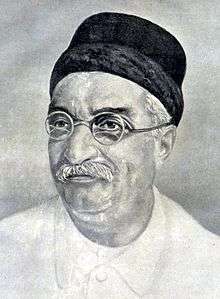Ardeshar Khabardar
| Ardeshar Faramji Khabardar | |
|---|---|
 | |
| Born |
6 November 1881 Daman, Portuguese India |
| Died |
30 July 1953 (aged 71) Madras, India |
| Occupation | poet |
| Language | Gujarati |
Ardeshar Faramji Khabardar, also spelled Ardeshir Pharamji Khabardar, was a Gujarati language poet from India. He wrote under the pen name Adal. Living in Bombay and Madras, he wrote in different styles of poetry and published around forty books. He wrote sonnets about Zoroastrianism also.
Life
Ardeshar was born in a Parsi family in Daman on 6 November 1881. He had primary education in Daman and secondary education from New Bharda Highschool, Bombay. He started a motorcycle accessories business in Madras in 1909. He presided over Gujarati Sahitya Parishad in 1941. He died in Madras on 30 July 1953.[1][2]
Works
He wrote under several pen names, chiefly under Adal. He wrote around forty books in Gujarati and two in English.[1][3]
His Gujarati poem, Jya Jya Vase Ek Gujarati, Tya Tya Sadakal Gujarat (Wherever a Gujarati resides, there forever is Gujarat) depicts Gujarati ethnic pride and is widely popular in Gujarat.[4]
He wrote in modern Gujarati instead of Parsi Gujarati. His first work was the poetry collection Kavyarasika, which followed the style of Dalpatram, in 1901. Vilasika, published in 1905, followed the style of Narsinhrao Divetia. Prakashika (1908) is styled as the works of Kalapi and Kant. Bharat no Tankar (1909) and Rashtrika (1940) are collections of patriotic songs. He parodied and satirised Gujarat no Tapasvi and Brahmadiksha of Nanalal as Prabhat no Tapasvi and Kutkutdiksha (1920) under the pen name Motalal. Sandeshika (1925) includes patriotic songs. His Kalika (1926) is a love song in blank verse style. Bhajanika (1928), Darshanika (1931) and Kalyanika (1940) are collections of devotional songs. Rasachandrika (1929, 1941) is a collection of rasa songs in the style of Nanalal and Botadkar. Shriji Iranshah no Pawado depicts the history of Zorostrianism and Gandhi Bapu no Pawado praises Mahatma Gandhi; both are poetry in Marathi powada style. Gandhi Bapu (1948) also has thirty-one songs dedicated to Gandhi. His last collection, Kirtanika, had seventy-five kirtan songs. He also published Malabari na Kavyaratno, an interpretation of poems of Behramji Malabari in 1913.[1][2][5][6][7][8]
His only English-language poetry collection The Silken Tassel (1918) had fifty-nine poems. He wrote New light on the Gathas of holy Zarathushtra and Zarathushtra: 101 sonnets depicting the life and teaching of Zoroaster.[1][9][10]
He started writing a play titled Manuraj or Vishwanatika styled on Goethe's Faust and Nanalal's free verse in 1936 but never completed or published.[1]
Bibliography
- Aradeśara Pharāmajī Khabaradāra (1990). The Rest House of the Spirit. Ajit Prakashan.
- Aradeśara Pharamājī Khabaradāra (1990). Leaf & Flower. Ajit Prakashan.
- Aradeśara Pharāmajī Khabaradāra (1990). The Migrating Bird. Ajit Prakashan on behalf of A.F. Khabardar Birth-Centenary Publications.
- Aradeśara Pharāmajī Khabaradāra (1918). The Silken Tassel. Theosophical Pub. House.
- Ardeshir F. Khabardar (1950). Zarathushtra, the first prophet of the world: 101 sonnets.
References
- 1 2 3 4 5 "Ardeshar Khabardar". Gujarati Sahitya Parishad (in Gujarati). Retrieved 18 August 2014.
- 1 2 Jeṭhālāla Nārāyaṇa Trivedī (1987). Love Poems & Lyrics from Gujarati. Gurjar Grantha Ratna Karyalaya. p. 181.
- ↑ Aradeśara Pharāmajī Khabaradāra; Dharmendra M. Master (1990). The Migrating Bird. Ajit Prakashan on behalf of A.F. Khabardar Birth-Centenary Publications.
- ↑ Raymond Brady Williams (1984). A New Face of Hinduism: The Swaminarayan Religion. CUP Archive. pp. 170–. ISBN 978-0-521-27473-9. Retrieved 18 August 2014.
- ↑ Sivasankari (1998). Knit India through literature. Eastwest Books. p. 296.
- ↑ Peter Brock (1995). Mahatma Gandhi as a Linguistic Nationalist. South Asia Publications. pp. 33–34. ISBN 978-0-945921-30-1.
- ↑ Sisir Kumar Das (1995). A history of Indian literature, 1911–1956: struggle for freedom : triumph and tragedy. Sahitya Akademi. ISBN 978-81-7901-798-2.
- ↑ Shastri, P. N.; P. Lal (1974). The Writers Workshop Handbook of Gujarati Literature: A-F. Writers Workshop. p. 37.
- ↑ Sheshalatha Reddy (2012). Mapping the Nation: An Anthology of Indian Poetry in English, 1870–1920. Anthem Press. pp. 263–. ISBN 978-0-85728-441-9.
- ↑ Nalini Natarajan; Emmanuel Sampath Nelson (1 January 1996). Handbook of Twentieth-century Literatures of India. Greenwood Publishing Group. p. 384. ISBN 978-0-313-28778-7.